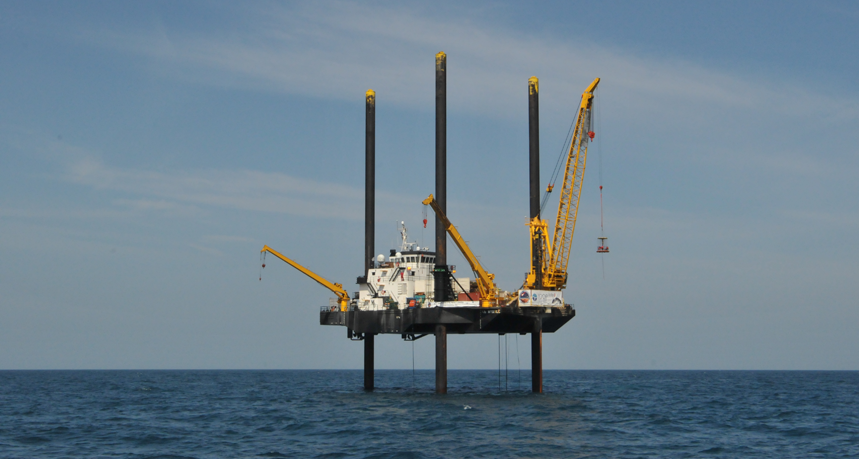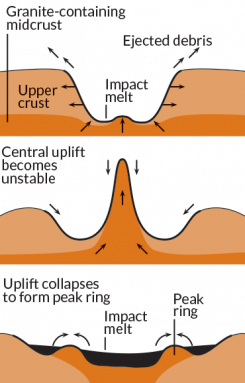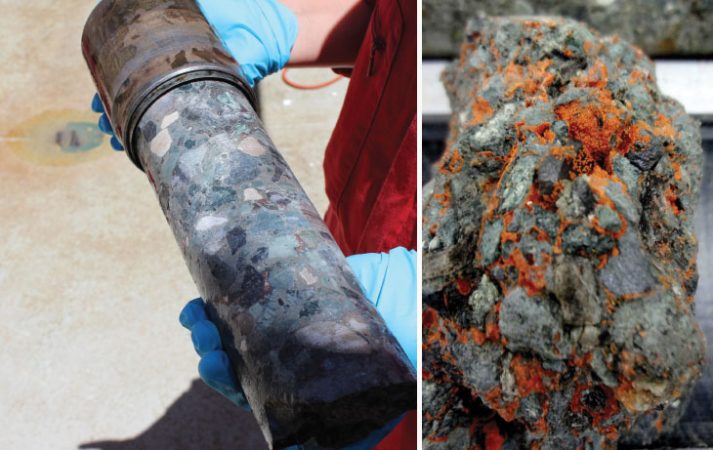Drilling into a dinosaur killer
Scientists are investigating the giant crater formed by an asteroid 66 million years ago

Scientists used the Myrtle drilling ship and its three towering legs to drill into the crater left behind by the Chicxulub impact.
The University of Texas at Austin Jackson School of Geosciences
Some 66 million years ago, an asteroid — or perhaps a comet — hit Earth. It struck off the coast of what is now the Yucatán Peninsula of Mexico. There, it formed a giant crater. This impact is thought to be at least partly responsible for a mass extinction that included the dinosaurs.
The site of this impact has been under investigation for a few decades. Its discovery started in 1980. That’s when a research team found lots of iridium in places worldwide. The metal is rare on Earth, but abundant in asteroids and other space rocks. Yet strangely, plenty of iridium shows up along the boundary between rocks from the Cretaceous and Paleogene periods.
It’s the first hard evidence for a killer-asteroid impact.
Eleven years later, scientists identified the smoking gun — that hidden crater. It circles the coastal Mexican town of Chicxulub Puerto (CHEEK-shuh-loob PWAIR-toh). Yet questions have remained about how the impact might have caused such global destruction.
For answers, scientists recently returned to the scene of the crime.
Evidence of a geologic upheaval

Reaching the Chicxulub crater takes effort. Tens of millions of years of slowly deposited sediment now enshrouds the crater to a depth of hundreds of meters (yards). Much is below the seafloor. The solution to studying it: the Myrtle drilling vessel.
This ship looks a bit awkward cruising the ocean. Three colossal black cylinders rise from the deck like fat masts lacking sails. That gives the ship a top-heavy look. Once in position, though, the ship transforms. The hulking cylinders drop to the seafloor. Then the ship jacks itself out of the water, standing tall on three legs like an oil rig.
Scientists set up this platform some 30 kilometers (19 miles) off the Yucatán Peninsula. From it, they probed deep underground in April and May 2016. They focused on a halo of hills that tower hundreds of meters (yards) above the crater floor. This peak ring formed in the aftermath of the impact. It is the only one of its kind on Earth.
Getting rocky evidence that had been locked inside the peak ring was key to understanding just how powerful the impact had been. It also helped resolve a mystery about how such large peak rings form.
Computers were used to model what happened. And these simulations now suggest that an impact churns deep rocks to the surface, leaving a circle of peaks. Some scientists had argued that the ring might have had a less violent origin. They said the ring might have formed from near-surface materials as the ground rebounded after the impact.
To confirm whether the computer model reflected reality required some seriously deep drilling, notes Sean Gulick. He is a geophysicist at the University of Texas at Austin. He also co-led the expedition.
His team drilled 1,334.7 meters (4,379 feet) below the seafloor. It took nearly two months at a cost of about $75 per centimeter (0.4 inch) of depth. But it proved worth it once the crater’s first impact-forged rocks were in hand, says Joanna Morgan. She is a geophysicist at Imperial College London. She also co-led the project.
The rocks are “dramatic,” Morgan says. They are a kaleidoscope of black, green, red and white minerals including granite.
“It looks like a fake kitchen countertop,” Gulick says. “No other rock looks like this.”
That granite solved the peak ring formation mystery — even before the ship returned to shore. In that region, minerals such as granite tend to be buried in Earth’s mid-crust, many kilometers (miles) below the surface. (The crust is the topmost layer of Earth.) Finding abundant granite in the relatively shallow peak ring means the models were right. The force of the impact indeed shoved deep material to the surface.
Story continues below image.

The researchers reported this November 18 in Science.
The lifted material flowed into the newly opened wound in Earth’s surface. There, it met in a giant column at the crater’s center before collapsing outward and forming a rocky ring roughly 550 meters (1,800 feet) high. All of this occurred within the first 10 minutes after the impact.
Scientists will use the data collected by the Chicxulub drilling team to improve computer models to better estimate how much energy and debris the impact unleashed, says Ross Potter. He is a planetary scientist at Brown University in Providence, R.I. Getting those numbers right is important. That’s because the blast itself wasn’t the big killer in the impact scenario. It was the darkness that followed. Blast debris darkened the skies and chilled the planet for years.







